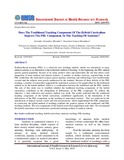| dc.contributor.author | Missankov, A. Alexander | |
| dc.contributor.author | Missankova, I. Krassimira | |
| dc.date.accessioned | 2015-12-08T13:58:48Z | |
| dc.date.available | 2015-12-08T13:58:48Z | |
| dc.date.issued | 2015-04-28 | |
| dc.identifier.citation | Missankov, A. A., & Missankova, K. I. (2015) Does the traditional teaching component of the hybrid curriculum improve the PBL component, in the teaching of anatomy? Int J Health Sci Res. 2015; 5(5):291-297. | en_US |
| dc.identifier.issn | 2249-9571 (online) | |
| dc.identifier.uri | http://hdl.handle.net/10311/1422 | |
| dc.description | Original Research Article | en_US |
| dc.description.abstract | Problem-based learning (PBL) is a relatively new teaching method, which was introduced in many medical schools as an alternative to the traditional method of teaching. At the beginning, the PBL method quickly gained popularity because of its many positive sides and particularly the one that allows early integration of basic medical and clinical sciences. A number of studies, however, reported that, in the PBL curriculum, the anatomical sciences (gross anatomy, histology and embryology) were insufficiently covered and the subjects were poorly understood by the students. Because of these deficits of the PBL teaching, a number of researchers suggested the anatomical sciences to be taught either by the traditional method or by the hybrid method, which is a combination between the traditional and the PBL method. The aim of this study was to establish whether the traditional teaching component, of the hybrid curriculum, contributes to the elimination of deficiencies of the PBL component. To achieve the objective, a data collection and analysis method was used. The results indicated that the traditional teaching component, of the hybrid curriculum, contributed significantly to the elimination of the deficiencies of the PBL component, in the teaching of anatomical sciences. This was achieved by the introduction of didactic lecture course and relevant practicals, which supplemented the PBL component. In conclusion, the hybrid method of teaching combines the positive aspects of the traditional and PBL teaching methods. The two components of the hybrid curriculum supplement each other. We recommend the hybrid curriculum to be turned into a preferred teaching method, in medical schools. | en_US |
| dc.language.iso | en | en_US |
| dc.publisher | ScopeMed Journal Management System | en_US |
| dc.rights | Open Access | en_US |
| dc.subject | PBL teaching | en_US |
| dc.subject | Traditional teaching | en_US |
| dc.subject | Hybrid curriculum | en_US |
| dc.subject | Anatomy teaching | en_US |
| dc.title | Does the traditional teaching component of the hybrid curriculum improve the PBL component, in the teaching of anatomy? | en_US |
| dc.type | Published Article | en_US |
| dc.rights.holder | International Journal of Health Sciences & Research | en_US |
| dc.link | http://www.scopemed.org/?jft=107&ft=107-1430897119 | en_US |

